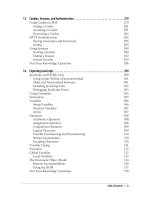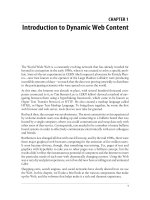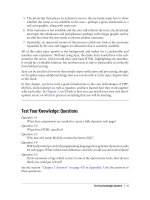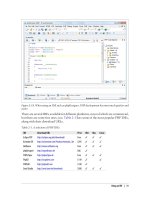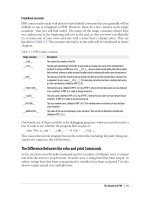Học php, mysql và javascript - p 7 pptx
Bạn đang xem bản rút gọn của tài liệu. Xem và tải ngay bản đầy đủ của tài liệu tại đây (1.93 MB, 10 trang )
three more arrays, as in Example 3-5, in which the array is set up with a game already
in progress.
Example 3-5. Defining a two-dimensional array
<?php
$oxo = array(array('x', '', 'o'),
array('o', 'o', 'x'),
array('x', 'o', '' ));
?>
Once
again, we’ve moved up a step in complexity, but it’s easy to understand if you
grasp the basic array syntax. There are three array() constructs nested inside the outer
array() construct.
To then return the third element in the second row of this array, you would use the
following PHP command, which will display an “x”:
echo $oxo[1][2];
Remember that array indexes (pointers at elements within an array) start
from zero, not one, so the [1] in the previous command refers to the
second of the three arrays, and the [2] references the third position
within that array. It will return the contents of the matchbox three along
and two down.
As mentioned, arrays with even more dimensions are supported by simply creating
more arrays within arrays. However, we will not be covering arrays of more than two
dimensions in this book.
Figure 3-4. A multidimensional array simulated with matchboxes
The Structure of PHP | 41
And don’t worry if you’re still having difficulty getting to grips with using arrays, as the
subject is explained in detail in Chapter 6.
Variable naming rules
When creating PHP variables, you must follow these four rules:
• Variable names must start with a letter of the alphabet or the _ (underscore)
character.
• Variable names can contain only the characters: a-z, A-Z, 0-9, and _ (underscore).
• Variable names may not contain spaces. If a variable must comprise more than one
word it should be separated with the _ (underscore) character. (e.g., $user_name).
• Variable names are case-sensitive. The variable $High_Score is not the same as the
variable $high_score.
Operators
Operators are the mathematical, string, comparison, and logical commands such as
plus, minus, times, and divide. PHP looks a lot like plain arithmetic; for instance, the
following statement outputs 8:
echo 6 + 2;
Before moving on to learn what PHP can do for you, take a moment to learn about the
various operators it provides.
Arithmetic operators
Arithmetic operators do what you would expect. They are used to perform mathemat-
ics. You can use them for the main four operations (plus, minus, times, and divide) as
well as to find a modulus (the remainder after a division) and to increment or decrement
a value (see Table 3-1).
Table 3-1. Arithmetic operators
Operator Description Example
+ Addition $j + 1
- Subtraction $j - 6
* Multiplication $j * 11
/ Division $j / 4
% Modulus (division remainder) $j % 9
++ Increment ++$j
Decrement $j
42 | Chapter 3: Introduction to PHP
Assignment operators
These operators are used to assign values to variables. They start with the very simple
= and move on to +=, -=, and so on (see Table 3-2). The operator += adds the value on
the right side to the variable on the left, instead of totally replacing the value on the
left. Thus, if $count starts with the value 5, the statement:
$count += 1;
sets $count to 6, just like the more familiar assignment statement:
$count = $count + 1;
Strings have their own operator, the period (.), detailed in the section “String concat-
enation” on page 46.
Table 3-2. Assignment operators
Operator Example Equivalent to
= $j = 15 $j = 15
+= $j += 5 $j = $j + 5
-= $j -= 3 $j = $j - 3
*= $j *= 8 $j = $j * 8
/= $j /= 16 $j = $j / 16
.= $j .= $k $j = $j . $k
%= $j %= 4 $j = $j % 4
Comparison operators
Comparison operators are
generally used inside a construct such as an if statement in
which you need to compare two items. For example, you may wish to know whether
a variable you have been incrementing has reached a specific value, or whether another
variable is less than a set value, and so on (see Table 3-3).
Note the difference between = and ==. The first is an assignment operator, and the
second is a comparison operator. Even more advanced programmers can sometimes
transpose the two when coding hurriedly, so be careful.
Table 3-3. Comparison operators
Operator Description Example
== Is equal to $j == 4
!= Is not equal to $j != 21
> Is greater than $j > 3
< Is less than $j < 100
>= Is greater than or equal to $j >= 15
<= Is less than or equal to $j <= 8
The Structure of PHP | 43
Logical operators
If you haven’t used them before, logical operators may at first seem a little daunting.
But just think of them the way you would use logic in English. For example, you might
say to yourself “If the time is later than 12pm and earlier than 2pm, then have lunch.”
In PHP, the code for this might look something like the following (using military
timing):
if ($hour > 12 && $hour < 14) dolunch();
Here we have moved the set of instructions for actually going to lunch into a function
that we will have to create later called dolunch. The then of the statement is left out,
because it is implied and therefore unnecessary.
As the previous example shows, you generally use a logical operator to combine the
results of two of the comparison operators shown in the previous section. A logical
operator can also be input to another logical operator (“If the time is later than 12pm
and earlier than 2pm, or if the smell of a roast is permeating the hallway and there are
plates on the table”). As a rule, if something has a TRUE or FALSE value, it can be input
to a logical operator. A logical operator takes two true-or-false inputs and produces a
true-or-false result.
Table 3-4 shows the logical operators.
Table 3-4. Logical operators
Operator Description Example
&& And $j == 3 && $k == 2
and Low-precedence and $j == 3 and $k == 2
|| Or $j < 5 || $j > 10
or Low-precedence or $j < 5 or $j > 10
! Not ! ($j == $k)
xor Exclusive or $j xor $k
Note that && is usually
interchangeable with and; the same is true for || and or. But
and and or have a lower precedence, so in some cases, you may need extra parentheses
to force the required precedence. On the other hand, there are times when only and or
or are acceptable, as in the following statement, which uses an or operator (to be ex-
plained in Chapter 10):
mysql_select_db($database) or die("Unable to select database");
The most unusual of these operators is xor, which stands for exclusive or and returns
a true value if either value is true, but a false value if both inputs are true or both
inputs are FALSE. To understand this, imagine that you want to concoct your own
cleaner for household items. Ammonia makes a good cleaner, and so does bleach, so
44 | Chapter 3: Introduction to PHP
you want your cleaner to have one of these. But the cleaner must not have both, because
the combination is hazardous. In PHP, you could represent this as:
$ingredient = $ammonia xor $bleach;
In the example snippet, if either $ammonia or $bleach is true, $ingredient will also be
set to true. But if both are true or both are false, $ingredient will be set to false.
Variable Assignment
The syntax to assign a value to a variable is always variable = value. Or, to reassign the
value to another variable, it is other variable = variable.
There are also a couple of other assignment operators that you will find useful. For
example, we’ve already seen:
$x += 10;
which tells the PHP parser to add the value on the right (in this instance, the value 10)
to the variable $x. Likewise, we could subtract as follows:
$y -= 10;
Variable incrementing and decrementing
Adding or subtracting 1 is such a common operation that PHP provides special oper-
ators for it. You can use one of the following in place of the += and -= operators:
++$x;
$y;
In conjunction with a test (an if statement), you could use the following code:
if (++$x == 10) echo $x;
This tells PHP to first increment the value of $x and then test whether it has the value
10; if it does, output its value. But you can also require PHP to increment (or, in the
following example, decrement) a variable after it has tested the value, like this:
if ($y == 0) echo $y;
which gives a subtly different result. Suppose $y starts out as 0 before the statement is
executed. The comparison will return a true result, but $y will be set to −1 after the
comparison is made. So what will the echo statement display: 0 or −1? Try to guess,
and then try out the statement in a PHP processor to confirm. Because this combination
of statements is confusing, it should be taken as just an educational example and not
as a guide to good programming style.
In short, whether a variable is incremented or decremented before or after testing de-
pends on whether the increment or decrement operator is placed before or after the
variable.
The Structure of PHP | 45
By the way, the correct answer to the previous question is that the echo statement will
display the result −1, because $y was decremented right after it was accessed in the if
statement, and before the echo statement.
String concatenation
String concatenation uses the period (.) to append one string of characters to another.
The simplest way to do this is as follows:
echo "You have " . $msgs . " messages.";
Assuming that the variable $msgs is set to the value 5, the output from this line of code
will be:
You have 5 messages.
Just as you can add a value to a numeric variable with the += operator, you can append
one string to another using .= like this:
$bulletin .= $newsflash;
In this case, if $bulletin contains a news bulletin and $newsflash has a news flash, the
command appends the news flash to the news bulletin so that $bulletin now comprises
both strings of text.
String types
PHP supports two types of strings that are denoted by the type of quotation mark that
you use. If you wish to assign a literal string, preserving the exact contents, you should
use the single quotation mark (apostrophe) like this:
$info = 'Preface variables with a $ like this: $variable';
In this case, every character within the single-quoted string is assigned to $info. If you
had used double quotes, PHP would have attempted to evaluate $variable as a variable.
On the other hand, when you want to include the value of a variable inside a string,
you do so by using double-quoted strings:
echo "There have been $count presidents of the US";
As you will realize, this syntax also offers a simpler form of concatenation in which you
don’t need to use a period, or close and reopen quotes, to append one string to another.
This is called variable substitution and you will notice some applications using it ex-
tensively and others not using it at all.
Escaping characters
Sometimes a string needs to contain characters with special meanings that might be
interpreted incorrectly. For example, the following line of code will not work, because
the second quotation mark encountered in the word sister’s will tell the PHP parser that
46 | Chapter 3: Introduction to PHP
the string end has been reached. Consequently, the rest of the line will be rejected as
an error:
$text = 'My sister's car is a Ford'; // Erroneous syntax
To correct this, you can add a backslash directly before the offending quotation mark
to tell PHP to treat the character literally and not to interpret it:
$text = 'My sister\'s car is a Ford';
And you can perform this trick in almost all situations in which PHP would otherwise
return an error by trying to interpret a character. For example, the following double-
quoted string will be correctly assigned:
$text = "My Mother always said \"Eat your greens\".";
Additionally you can use escape characters to insert various special characters into
strings such as tabs, new lines, and carriage returns. These are represented, as you might
guess, by \t, \n, and \r. Here is an example using tabs to lay out a heading; it is included
here merely to illustrate escapes, because in web pages there are always better ways to
do layout:
$heading = "Date\tName\tPayment";
These special backslash-preceded characters work only in double-quoted strings. In
single-quoted strings, the preceding string would be displayed with the ugly \t se-
quences instead of tabs. Within single-quoted strings, only the escaped apostrophe
(\') and escaped backslash itself (\\) are recognized as escaped characters.
Multiple-Line Commands
There are times when you need to output quite a lot of text from PHP and using several
echo (or print) statements would be time-consuming and messy. To overcome this,
PHP offers two conveniences. The first is just to put multiple lines between quotes, as
in Example 3-6. Variables can also be assigned, as in Example 3-7.
Example 3-6. A multiline string echo statement
<?php
$author = "Alfred E Newman";
echo "This is a Headline
This is the first line.
This is the second.
Written by $author.";
?>
Example 3-7. A multiline string assignment
<?php
$author = "Alfred E Newman";
The Structure of PHP | 47
$text = "This is a Headline
This is the first line.
This is the second.
Written by $author.";
?>
PHP
also offers
a multiline sequence using the <<< operator, commonly referred to as
here-document or heredoc for short, and is a way of specifying a string literal, preserving
the line breaks and other whitespace (including indentation) in the text. Its use can be
seen in Example 3-8.
Example 3-8. Alternative multiline echo statement
<?php
$author = "Alfred E Newman";
echo <<<_END
This is a Headline
This is the first line.
This is the second.
- Written by $author.
_END;
?>
What this code does is tell PHP to output everything between the two _END tags as if it
were a double-quoted string. This means it’s possible, for example, for a developer to
write entire sections of HTML directly into PHP code and then just replace specific
dynamic parts with PHP variables.
It is important to remember that the closing _END; tag must appear right at the start of
a new line and it must be the only thing on that line—not even a comment is allowed
to be added after it (nor even a single space). Once you have closed a multiline block,
you are free to use the same tag name again.
Remember: using the <<<_END _END; heredoc construct,
you don’t
have to add \n linefeed characters to send a linefeed—just press Return
and start a new line. Also, unlike either a double-quote- or single-quote-
delimited string, you are free to use all the single and double quotes you
like within a heredoc, without escaping them by preceding them with a
slash (\).
Example 3-9 shows how to use the same syntax to assign multiple lines to a variable.
Example 3-9. A multiline string variable assignment
<?php
$author = "Alfred E Newman";
$out = <<<_END
48 | Chapter 3: Introduction to PHP
This is a Headline
This is the first line.
This is the second.
- Written by $author.
_END;
?>
The
variable $out
will then be populated with the contents between the two tags. If you
were appending, rather than assigning, you could also have used .= in place of = to
append the string to $out.
Be careful not to place a semicolon directly after the first occurrence of _END as that
would terminate the multiline block before it had even started and cause a “Parse error”
message. The only place for the semicolon is after the terminating _END tag, although
it is safe to use semicolons within the block as normal text characters.
By the way, the _END tag is simply one I chose for these examples because it is unlikely
to be used anywhere else in PHP code and is therefore unique. But you can use any tag
you like such as _SECTION1 or _OUTPUT and so on. Also, to help differentiate tags such
as this from variables or functions, the general practice is to preface them with an
underscore, but you don’t have to use one if you choose not to.
Laying out text over multiple lines is usually just a convenience to make your PHP code
easier to read, because once it is displayed in a web page, HTML formatting rules take
over and whitespace is suppressed, but $author is still replaced with the variable’s value.
Variable Typing
PHP is a very loosely typed language. This means that variables do not have to be
declared before they are used, and that PHP always converts variables to the type re-
quired by their context when they are accessed.
For example, you can create a multiple-digit number and extract the nth digit from it
simply by assuming it to be a string. In the following snippet of code, the numbers
12345 and 67890 are multiplied together, returning a result of 838102050, which is
then placed in the variable $number, as shown in Example 3-10.
Example 3-10. Automatic conversion from a number to a string
<?php
$number = 12345 * 67890;
echo substr($number, 3, 1);
?>
At the point of the assignment, $number is a numeric variable. But on the second line,
a call is placed to the PHP function substr, which asks for one character to be returned
from $number, starting at the fourth position (remembering that PHP offsets start from
zero). To do this, PHP turns $number into a nine-character string, so that substr can
access it and return the character, which in this case is 1.
The Structure of PHP | 49
The same goes for turning a string into a number and so on. In Example 3-11, the
variable $pi is set to a string value, which is then automatically turned into a floating-
point number in the third line by the equation for calculating a circle’s area, which
outputs the value 78.5398175.
Example 3-11. Automatically converting a string to a number
<?php
$pi = "3.1415927";
$radius = 5;
echo $pi * ($radius * $radius);
?>
In practice, what this all means is that you don’t have to worry too much about your
variable types. Just assign them values that make sense to you and PHP will convert
them if necessary. Then, when you want to retrieve values, just ask for them—for ex-
ample, with an echo statement.
Constants
Constants are similar to variables, holding information to be accessed later, except that
they are what they sound like—constant. In other words, once you have defined one,
its value is set for the remainder of the program and cannot be altered.
One example of a use for a constant might be to hold the location of your server root
(the folder with the main files of your website). You would define such a constant like
this:
define("ROOT_LOCATION", "/usr/local/www/");
Then, to read the contents of the variable you just refer to it like a regular variable (but
it isn’t preceded by a dollar sign):
$directory = ROOT_LOCATION;
Now, whenever you need to run your PHP code on a different server with a different
folder configuration, you have only a single line of code to change.
The main two things you have to remember about constants are that
they must not be prefaced with a $ sign (as with regular variables), and
that you can define them only using the define function.
It is generally
agreed to be good practice to use only uppercase for constant variable
names, especially if other people will also read your code.
50 | Chapter 3: Introduction to PHP

